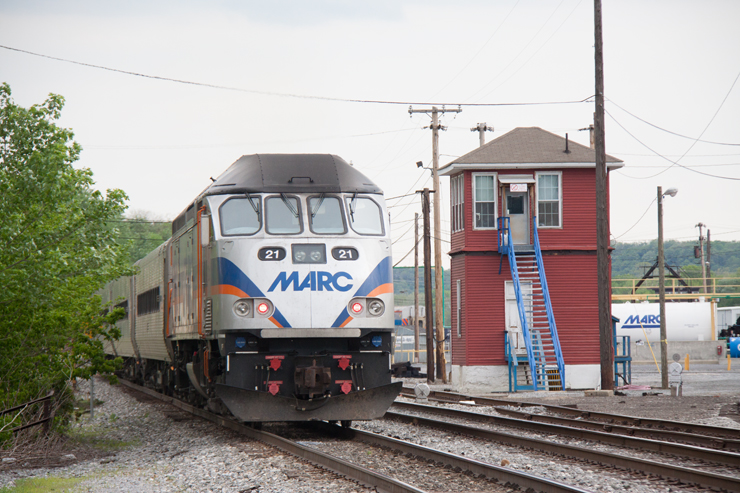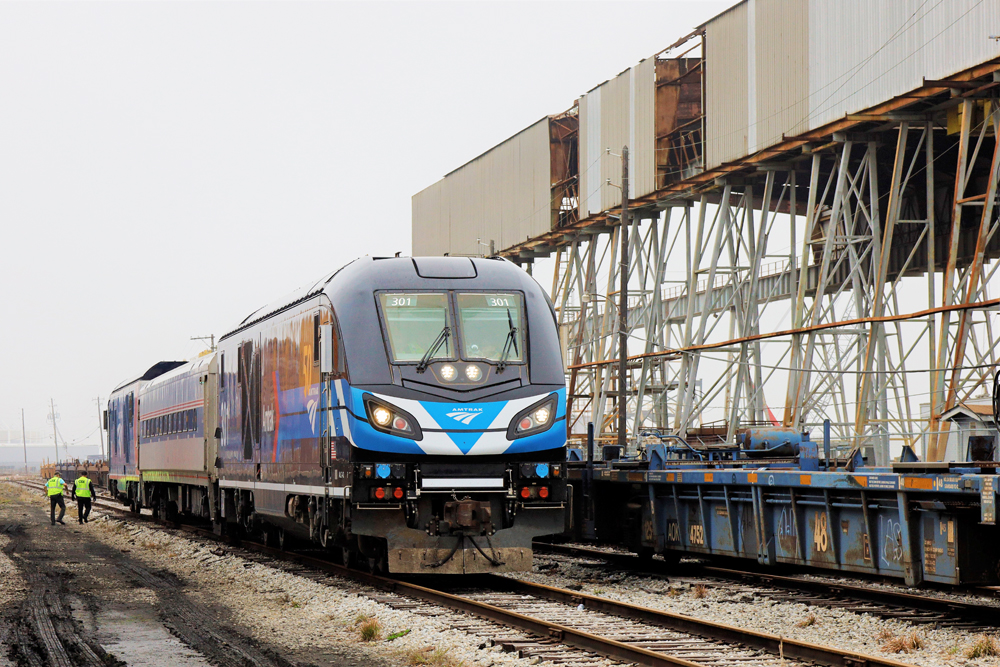
ANNAPOLIS, Md. — Maryland’s Department of Transportation has signed agreements with agencies in Delaware and Virginia to explore expansion of MARC commuter rail service into those states, Gov. Wes Moore announced Thursday.
The agreements are steps toward potential run-through service sought by MARC to Newark, Del., and Alexandria, Va.
Discussions with the Delaware Transit Corp. will seek to determine operational and infrastructure needs to close a gap that would allow MARC to connect with the Southeastern Pennsylvania Transportation Authority system. The agreement with the Virginia Passenger Rail Authority aims to eventually allow MARC trains to continue past Washington Union Station on routes currently served by Virginia Railway Express. In the short term, the two systems will seek to improve connections at Union Station.
The Washington Post reports MARC and VRE are also exploring the possibility of honoring each other’s tickets. The Post notes major infrastructure projects — notably the completion of the second Long Bridge across the Potomac — would be needed before MARC trains could continue into Virginia [see “Virginia seeks additional funding for Long Bridge project,” Trains News Wire, April 10, 2023]. Agreements would also need to be negotiated involving CSX Transportation and Amtrak.
“We must take a regional approach to create a fully connected transportation network, and these agreements will help us deliver seamless transit service across state lines,” Maryland Transportation Secretary Paul J. Wiedefeld said in a press release. “Maryland is working to create a transit network that expands opportunities and options for all customers. Collaboration with our partners in Virginia and Delaware is critical in that mission.”
Virginia Passenger Rail Authority Executive Director DJ Stadler said the framework agreement is “an important first step forward for VPRA to further advance the Commonwealth’s goal of reducing congestion on our roads and highways by providing more reliable, consistent, and accessible passenger rail transportation options. We look forward to continued coordination with the Maryland Transit Administration as we work to better connect people and communities across the region.”
The idea of greater connectivity between MARC and VRE is not new; a 2020 report from the Greater Washington Partnership suggested combining the two into a single operation [see “Digest: Report recommends combining VRE, MARC …,” News Wire, Dec. 10, 2020]














Not all trains stop at New London. The Acela does not stop, unless there is a special exception. One morning we stopped at New London as the mid-morning Acela was the first train from BOS to NYP that day due to storms.
Delaware does not operate its commuter trains. Instead, they contract with SEPTA to extend Phila-Marcus Hook trains to Wilmington and Newark DE. Ticketing is the same as anywhere else on SEPTA.
In answer to another question, SEPTA and NJ Transit sell through tickets between Philadelphia and NY Penn Sta. SEPTA to Trenton, change trains there. Much cheaper than Amtrak and no reservations required.
The State of Delaware contracts with SEPTA to operate the current service between Philadelphia and Claymont, Wilmington and Newark DE. SEPTA also operates into Trenton NJ where they connect with NJT for Newark NJ, NY Penn and Hoboken.
NOTE: the two Newarks are pronounced differently: Newark DE is New ARK and Newark NJ is NEW urk.
https://s3.amazonaws.com/schedules.septa.org/current/WIL.pdf
https://s3.amazonaws.com/schedules.septa.org/current/TRE.pdf
https://content.njtransit.com/sites/default/files/printable%20schedules%20Nov%202022/NEC-WKDY-111322.pdf
https://content.njtransit.com/sites/default/files/printable%20schedules%20Nov%202022/NEC-WKND-111322.pdf
Any effort to expand service and coordinate with other local service providers should be encouraged. If the goal is to convince the public to use transit rather than drive a car then coordinated local service is a must. Think like the E-Z pass system for cars. You buy it from your local toll road provider but it is useable over many other toll road authorities. If SEPTA,MARC and VRE can coordinate service and fares it will open more opportunities for local transit service between the local state supported transit service. Amtrak is good for its fast through trains to larger cities and some suburban stations. However the local trains serve many more stations and open the chance people will choose transit to get to their destinations. If fares and service can be designed to connect the various local train operators ridership should increase and help lower the cost to operate the existing train network. A win for all with some work to accomplish this task at the various transit authorities.
Add NJT, MN, CTRail, ShoreLine East & MBTA, and you’d have the makings of a new Commuter/Regional RailCard-type pass.
MATTHEW —
When I was a child, when ticketing was done by hand and by telephone, I could buy a ticket that would transfer me from a New Haven Railroad intercity train to New Haven’s Providence Local.
Now with more computers on this Earth than there are people, I can’t buy a ticket that will transfer me from the Amtrak Hiawatha to a METRA train.
Charles,
Even if you could buy a transferable ticket (Amtrak and Metrolink has Rail-to-Rail along the overlapping Surfliner corridor), the don’t share schedules with each other so the uninformed public may plan a trip. The LOSSAN corridor is supposed to be working on this. Pre-Covid I remember seeing a master LOSSAN timetable showing all Amtrak, Metrolink and Coaster trains, but Amtrak has since abandoned public timetables.
The other problem is they do not schedule their trains so that passengers may transfer with each other! If I want to travel from Santa Barbara to San Bernardino, my connecting Metrolink train would either have left minutes before my arrival at LAUPT, or I would have a long layover. LOSSAN is supposed to be working with Amtrak and Metrolink to make their services seamless, but I haven’t heard, or seen anything on this in months. I will give them a break on rolling the changes out, due to the slope stabilization closure project between San Clemente and Oceanside.
Perhaps, others can address changes to Amtrak – Commuter scheduling and seamless transferring?
Wonderful News, now if only Shore Line East & the MBTA would extend to Westerly, a full commuter/regional rail trip up the corridor would be possible!
After MetroNorth trains start running to Penn Station, the MBTA/Shoreline East gap would be the only one.
I wonder if that would spell the end for the Northeast Regionals. VIA service in parts of the Quebec City-Windsor Corridor west of Toronto has been increasingly usurped by GO Transit in recent years.
Mr. Gromalac: Before a credible volume of local service can be mixed with Amtrak trains making limited stops between New Haven and Boston, there needs to be significant track capacity expansion. It won’t do local service riders any good if their train gets held for an Amtrak overtake or Amtrak riders any good if their train is poking along following an all-stops local. All I can say is “Good luck with the capacity expansion”. Remember a few years ago there was a proposal, blessed by the FRA no less, to build a bypass around New London. The new route was proposed to leave the NEC at Old Saybrook, don’t remember if east or west of the Conn River bridge, and return to the Corridor somewhere in RI west of Providence. And the Democrats, supposedly the party that supports Amtrak and transit, shut it down!!! Then CT Gov. Dannell Malloy and CT U.S. Senator Richard Blumenthal spearheaded the fight to stop it. I guess they along with all the local pols were trying to curry favor with the well-heeled residents of East Lyme and surrounding towns who didn’t want trains anywhere near their paradises on Earth. And then-RI Gov. Gina Raimondo got on their bandwagon even though RI didn’t have a dog in that fight! Not only wasn’t RI effected but their original demand from back when studies of a new route were first begun that any new routing not bypass Providence, was granted. And it all died and now Amtrak is condemned to that god-awful slow nearly 10 mile trek through New London.
MARK —
Normally I’m not on board with wealth NIMBYs or Democrat politicians voted in by wealthy NIMBYs. This time they may have a case. Bypasses aren’t that easy, as we have found at Lac Megantic (and this area of SE Connecticut/ SW Rhode Island is far more developed). Trains go through cities, not around them, and there’s plenty of high speed running through other cities in this world. New London is different (and slower) because of the geography. I never noticed the speed restriction. All trains stop in New London, so I figured it was slowing for the station stop.
As for NEC train delays due to slower local trains on double iron, I’d not worry with the small frequencies that would occur. There’s far more commuter trains on the double iron Boston to Providence —- and that’s one of the highest speed segments anywhere in the Western Hemisphere.